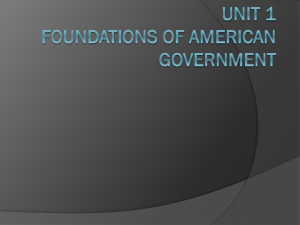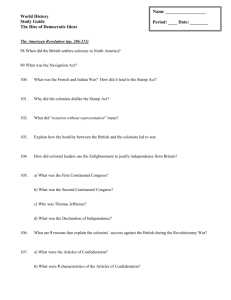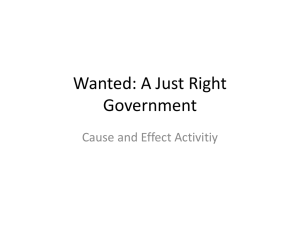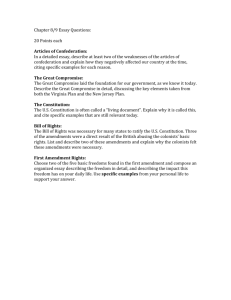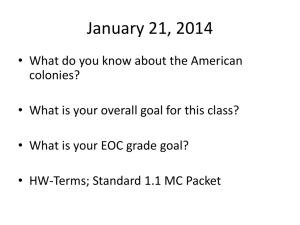Chapter 5 and 6 Test - Genrich
advertisement
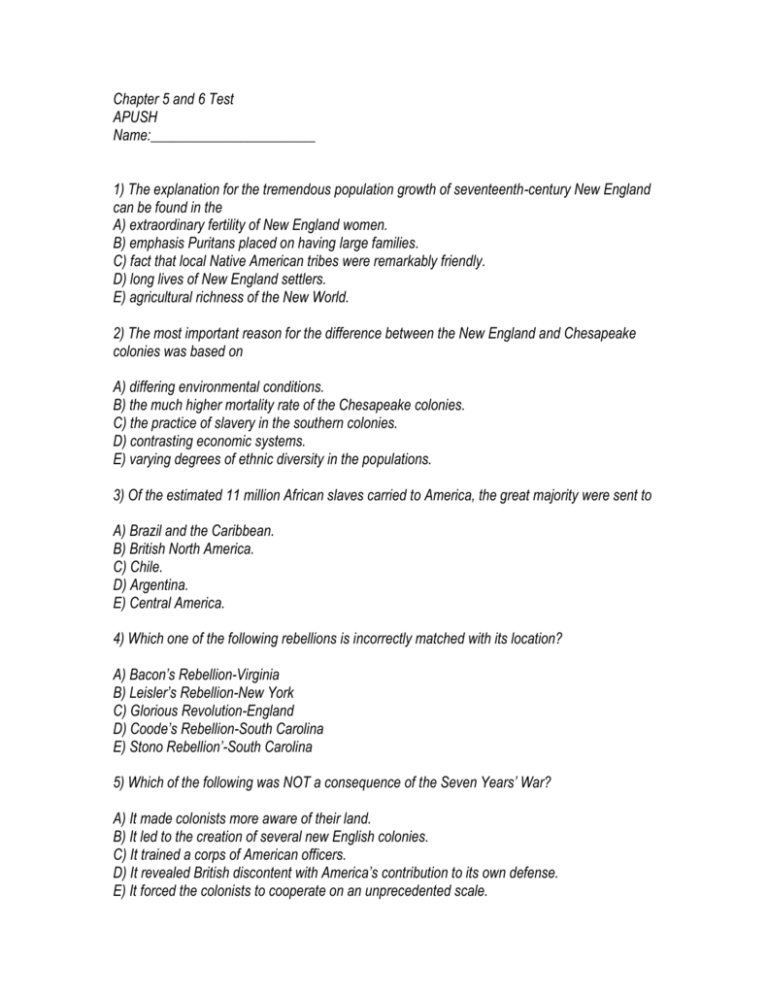
Chapter 5 and 6 Test APUSH Name:_______________________ 1) The explanation for the tremendous population growth of seventeenth-century New England can be found in the A) extraordinary fertility of New England women. B) emphasis Puritans placed on having large families. C) fact that local Native American tribes were remarkably friendly. D) long lives of New England settlers. E) agricultural richness of the New World. 2) The most important reason for the difference between the New England and Chesapeake colonies was based on A) differing environmental conditions. B) the much higher mortality rate of the Chesapeake colonies. C) the practice of slavery in the southern colonies. D) contrasting economic systems. E) varying degrees of ethnic diversity in the populations. 3) Of the estimated 11 million African slaves carried to America, the great majority were sent to A) Brazil and the Caribbean. B) British North America. C) Chile. D) Argentina. E) Central America. 4) Which one of the following rebellions is incorrectly matched with its location? A) Bacon’s Rebellion-Virginia B) Leisler’s Rebellion-New York C) Glorious Revolution-England D) Coode’s Rebellion-South Carolina E) Stono Rebellion’-South Carolina 5) Which of the following was NOT a consequence of the Seven Years’ War? A) It made colonists more aware of their land. B) It led to the creation of several new English colonies. C) It trained a corps of American officers. D) It revealed British discontent with America’s contribution to its own defense. E) It forced the colonists to cooperate on an unprecedented scale. 6) The British commander who surrendered at Yorktown in 1781 was A) Howe. B) Gage. C) Cornwallis. D) Paine. E) Clinton. 7) The Treaty of Paris of 1783 A) established the American borders at the Appalachian Mountains. B) ensured Loyalists would not be compensated for their lands. C) did not provide a favorable conclusion to the war. D) allowed Americans the opportunity for an independent nation. E) did not include compensation for Loyalists whose lands had been confiscated. 8) American Loyalists, who sided with the British during the War for Independence, A) tended to be wealthy conservatives. B) were known for their wickedness and immorality. C) favored a strongly centralized, authoritarian form of government. D) came from all occupations and social classes. E) were pacifists who opposed war for any reason. 9) Approximately ________ Loyalists left America after the war. A) 10,000 B) 100,000 C) 200,000 D) 300,000 E) 500,000 10) Which of the following was NOT a task facing the new nation? A) what form the new government would take B) how political power would be distributed C) how to ensure political equality for all D) how to fend off French attempts to control our country E) the division of state and federal authority 11) The author of the Declaration of Independence was A) George Washington. B) Benjamin Franklin. C) Samuel Adams. D) Patrick Henry. E) Thomas Jefferson. 12) The Declaration of Independence A) stated that all men “are created equal.” B) blamed George III for much of the impasse. C) was unanimously approved with no alterations. D) both A and B E) both A and C 13) During the early months of the Revolutionary War, American soldiers A) received excellent training. B) despaired of ever defeating the superior British army. C) were excessively overconfident about their chances of victory. D) rebelled against Washington’s leadership. E) were mentally prepared for a long, difficult fight. 14) Which of the following explains why England lost the war? A) The British government did not believe it could win the war. B) British finances could not support the war. C) British strategists did not understand how to fight the war. D) George III never supported the war effort. E) British soldiers sympathized with the Americans. 15) The Tea Act of 1773 was passed in order to A) save the East India Company. B) raise revenue to pay royal governorsʹ salaries. C) punish colonists for the Boston Massacre. D) support the stationing of British troops in America. E) recover revenue lost by reducing the tax on molasses. 16) England passed the Coercive Acts in response to A) the colonial boycott of the Stamp Act. B) the Boston Tea Party. C) the American victory at Saratoga. D) the Declaratory Act. E) the Tea Act. 17) The ________ extended Canadian boundaries into the Ohio Valley and recognized civil rights for Roman Catholics. A) Quebec Act B) Stamp Act C) Declaratory Act D) Townshend Acts E) Montreal Act 18) A major difficulty that confronted the First Continental Congress was A) the refusal of its delegates to challenge British authority. B) Parliament’s decision to declare the meeting illegal. C) the bad weather that prevented some delegates from attending. D) Virginia’s refusal to send delegates. E) the fact that the delegates from different regions were unfamiliar with one another. 19) American colonists, in the years just after the conclusion of the Seven Yearsʹ War, could be characterized best as A) hostile toward the British. B) optimistic about the future. C) apathetic about colonial-British relations. D) eager for independence from Great Britain. E) trying to rebuild. 20) On the eve of the American Revolution, approximately ________ million people were living in the thirteen colonies. A) 2.5 B) 3.5 C) 4.5 D) 5 E) 5.2 21) George III believed A) Parliament should run the empire. B) the monarch should make policies for the empire. C) the monarch should be a figurehead. D) qualified men should run the government. E) the monarch should consider parliamentary opinion when making decisions. 22) In the 1760s and 1770s, most members of Parliament A) were well-informed in colonial affairs. B) were creative in their solutions to colonial problems. C) had little understanding or knowledge of colonial affairs. D) feared the power of the colonial assemblies. E) had invested money in the colonies. 23) The central issue in the Anglo-American debate over governance was A) divine sovereignty. B) laissez faire. C) parliamentary sovereignty. D) absolute rule. E) colonial sovereignty. 24) Central to the colonists’ position in the Anglo-American debate over parliamentary powers was A) their strong belief in the powers of their own provincial assemblies. B) their unswerving support of the monarchy. C) their willingness to defer to the wishes of Parliament. D) their desire for an authoritarian government. E) their desire for revolution. 25) In the 1760s and 1770s, colonists viewed the political struggle with Britain in terms of A) haves against have-nots. B) democracy against aristocracy. C) good against evil. D) West against East. E) agriculture against industrialization. 26) The English political philosopher most often cited by American rebels was A) Thomas Paine. B) Edmund Burke. C) William Pitt. D) John Locke. E) David Hume. 27) A major source of information for the colonists was A) newspapers. B) books. C) church meetings. D) the market-place. E) the town crier. 28) The best definition of republican, as it was understood in the late 1700s, was A) a government without monarchy or aristocracy. B) a new political party. C) a continuation of the British monarchy. D) a strong central government. E) ‘one man, one vote.’ 29) The law permitting a man to pass on his entire estate to his eldest son was known as A) access. B) primogeniture. C) federalism. D) land tenure. E) the law of entail. 30) The uproar surrounding the formation of the Society of the Cincinnati was triggered by A) public fears that this was the beginning of an hereditary peerage in America. B) angry women, since membership was exclusively male. C) religious leaders who felt the society was pagan in its rituals. D) parents who feared the consequences of young men and women meeting without chaperones. E) southerners who questioned the society’s anti-slavery stance. 31) Which of the following was NOT a result of the American Revolution? A) the end of primogeniture B) disestablishment of the Anglican Church in several southern states C) abolition of slavery in several southern states D) reductions in the minimum property requirement for voting E) the continued uneven distribution of wealth 32) The leading African-American scientist and mathematician in early America was A) John Woolman. B) Richard Allen. C) Benjamin Banneker. D) Sojourner Truth. E) Phillis Wheatley. 33) Even before achieving statehood, ________ prohibited slavery in its constitution. A) Connecticut B) New Jersey C) Massachusetts D) Pennsylvania E) Vermont 34) With respect to women, the political ideology of the American Revolution A) had little interest for them. B) brought dramatic changes in their lifestyles and opportunities. C) caused them to be more assertive about their roles in the family. D) gave them the right to participate actively in government. E) brought them together to demand suffrage. 35) How many states did not have to draft new constitutions, since they already had republican governments as part of their colonial charters? A) none B) one C) two D) three E) four 36) John Dickinson’s 1776 plan for a new United States government revolved around the concept of A) a weak central government. B) extremely powerful state governments. C) unification with Canada. D) a strong central government. E) a centralized banking system. 37) The Articles of Confederation A) gave too much power to the central government. B) provided for state representation by population. C) jealously guarded state sovereignty at the expense of national power. D) created a powerful presidency. E) changed little from first draft to final document. 38) The controversy which delayed ratification of the Articles of Confederation involved A) slavery. B) the disposition of western lands. C) American relations with European countries. D) regulating trade with British manufacturers. E) boundaries between the states. 39) Which of the following was NOT a criticism of American government under the Articles of Confederation? A) that it failed to deal with the nation’s economic problems B) that it gave too much power to a central government C) that it failed to adequately confront threats from Britain and Spain along U.S. borders D) that it was unable to deal with the country’s fiscal instability E) that its single legislative body gave some states an unfair advantage 40) Under the terms of the ________, an orderly process for laying out lands and towns in the western territory was established. A) Land Ordinance of 1785 B) Northwest Ordinance of 1787 C) Proclamation of 1763 D) Cumberland Agreement E) Ordinance of 1784 41) The Northwest Ordinance of 1787 A) defined the process by which a territory became a state. B) provided for the surveying of the Northwest Territory. C) ignored the basic rights of settlers in the region. D) specifically allowed slavery to exist in the region. E) was one of the first acts passed under the Confederation. 42) During the Confederation period, nationalists were people who A) supported the Articles of Confederation. B) believed the national government was too powerful. C) called for major constitutional reforms that would strengthen the national government. D) believed the states deserved more power. E) wanted to maintain close ties to England. 43) The Newburgh Conspiracy involved A) discontented officers of the Continental Army. B) supporters of the Articles of Confederation. C) those who believed the Articles gave too much power to the national government. D) individuals dissatisfied with the military leadership of George Washington. E) French soldiers who had not been paid. 44) An important procedural decision approved at the opening of the Constitutional Convention involved A) publicizing the convention’s meetings and debates. B) its refusal to allow the small states to present their plans for constitutional revisions. C) the decision to keep deliberations as secret as possible. D) the election of James Madison as chairman. E) the requirement of a plurality rather than a simple majority to implement changes. 45) The Virginia Plan was the handiwork of A) William Ruffin. B) Patrick Henry. C) Thomas Jefferson. D) Ben Franklin. E) James Madison. 46) The plan proposed by William Paterson A) gave too much power to the national government. B) proposed a two-house national legislature. C) represented the wishes of the smaller states. D) was strongly supported by Madison and his colleagues. E) denied Congress power to tax or regulate trade. 47) The ________ proposed a unicameral Congress in which the states would be represented equally. A) Virginia Plan B) “three-fifths rule” C) Connecticut Plan D) Franklin Compromise E) New Jersey Plan 48) The compromise which resolved the dispute between the large and the small states included each of the following EXCEPT A) the states would be equally represented in the upper house. B) all bills pertaining to taxation or spending would begin in the upper house. C) the states would be proportionally represented according to population in the lower house. D) slave-holding states could count sixty percent of their slaves for purposes of representation. E) in the lower house, at the beginning, there would be one representative for every 30,000. 49) The three-fifths rule concerned the issue of A) slavery. B) the number of branches in the national government. C) checks and balances. D) presidential power. E) the number of votes required in the House to pass legislation. 50) In order for the Constitution to be accepted, A) nine state legislatures needed to ratify it. B) a unanimous vote among the states needed to occur. C) nine state conventions needed to ratify it. D) the public needed to ratify it. E) three-fifths of all state legislators needed to ratify it. 51) Those who campaigned actively for ratification of the Constitution were called A) Nationalists. B) Federalists. C) Constitutionalists. D) States’ Righters. E) Antifederalists. 52) Those who opposed ratification of the Constitution were called A) Antifederalists B) Federalists. C) States’ Righters. D) Radicals. E) Nationalists. 53) The first state to ratify the new Constitution was A) South Carolina. B) Massachusetts. C) Delaware. D) New Hampshire. E) Rhode Island. 54) The Federalist was a series of essays written by A) Washington and Adams. B) Thomas Jefferson. C) Madison, Hamilton, and Jay. D) Randolph and Franklin. E) Madison, Jefferson, and Hamilton. 55) Federalists can be closely associated with A) a desire to preserve the Articles of Confederation. B) proposing that the Bill of Rights be added to the Constitution. C) the idea of a strong central government. D) the idea of states’ rights. E) the early abolition movement. 56) A major fear of the Antifederalists was that A) voters would be too distanced from their representatives. B) voters would have too much direct contact and, thus, influence on their representatives. C) voters would corrupt their national representatives. D) national representatives would rely too consistently on local voters for their ideas and decisions. E) the average voter was not educated enough to make good decisions. 57) The Constitution was ratified A) easily in all the major states. B) by close votes in the major states. C) with little opposition from farmers. D) with great opposition from artisans and merchants. E) within eight months.


